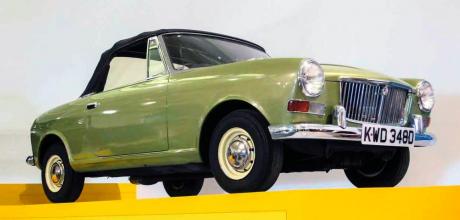1961 ADO 34 - Mini-based sports car
Not one but two attempts were made to spin a two-seater sports car off the original Mini’s platform, but flaws in their designs would see both stall at the prototype stage.
DOA: 1961 mini-based sports cars
This edition of DOA is a twofer, as we look at a pair of projects that tried to turn the original Mini into a two-seater sports car. The first, codenamed ADO 34, came about when the Mini itself was in development, as Longbridge engineer Jack Daniels drew up plans to adapt the new car’s subframes for a small, front-wheel- drive MG. Unfortunately, MG had decided to rebody the rear-drive Austin Healey Sprite to make the entry-level Midget of 1961, but the FWD idea didn’t go away and at the start of the ’60s work continued on two separate ADO 34 projects.
The first was by MG engineers at Abingdon and used the longer wheelbase of the Mini Countryman estate, dressed in a somewhat amphibious-looking body with overtones of the soon-to-be-launched MGB. The lone running prototype suffered from terrible scuttle shake and this lack of body rigidity quickly killed MG’s ADO 34 stone dead.
Up at Longbridge, meanwhile, engineers on a parallel ADO 34 project were packing up a pair of Mini subframes and an A-series engine in spicier Cooper tune to be sent down to Pininfarina in Turin. The Italians solved the rigidity problem by joining the subframes with a separate chassis and then wrapping it in a pretty body (pictured below) that looked tantalisingly ready for the showroom. Unfortunately, the Farina-built ADO 34 had several problems, not least that it was essentially a bespoke car, sharing too little with the Mini to make economic sense. Issigonis hated it, and it would be fair to assume MG people weren’t too keen either, given that their own ADO 34 had failed. In 1964 the project was cancelled.
Our story then jumps forward to March 1970, when Austin Morris management, realising the MG Midget was getting old, ordered an investigation into a Mini-based replacement under the codename ADO 70. Longbridge designer Paul Hughes came up with a concept for a targa-topped two-seater, and by the following month his sketches had been turned into a full-size mock-up. The bosses were so impressed they gave the go-ahead for Michelotti to build a running prototype and in May 1970 another designer, Rob Owens, packed Hughes’s sketches into a Mini Clubman 1275 GT and drove from Birmingham to Turin with an instruction to stay there and keep an eye on things until the Clubman had been dismembered and rebuilt into a sports car.
Two months later the transformation was complete. The car (pictured left) was a secret future model and had been hand-built at huge expense by a top Italian design house, so it’s surprising to learn that Owens then simply drove it all the way back to Birmingham. The reception it received on its arrival at Longbridge was not entirely rapturous. Original designer Paul Hughes reckoned Michelotti hadn’t faithfully reproduced his design. The handmade nature of the prototype also made it heavy, which in turn blunted the performance and handling. And the fashionable targa top didn’t seal properly and had leaked during the trip back from Italy, soaking the interior so that the prototype stank like a wet dog.
After the giddy speed with which ADO 70 had raced from sketch to running prototype, enthusiasm for the idea evaporated with similar haste and the project was swiftly abandoned. The Michelotti-made runner was dumped in a corner at Longbridge where it was allowed to rot for many years before being rescued and restored. Today it lives in the British Motor Museum in Warwickshire, alongside the Pininfarina ADO 34.


